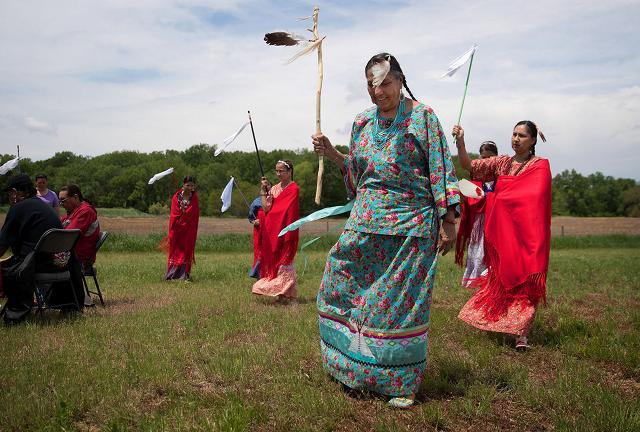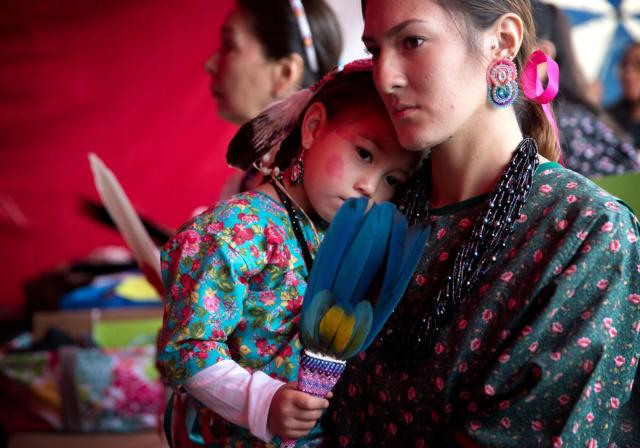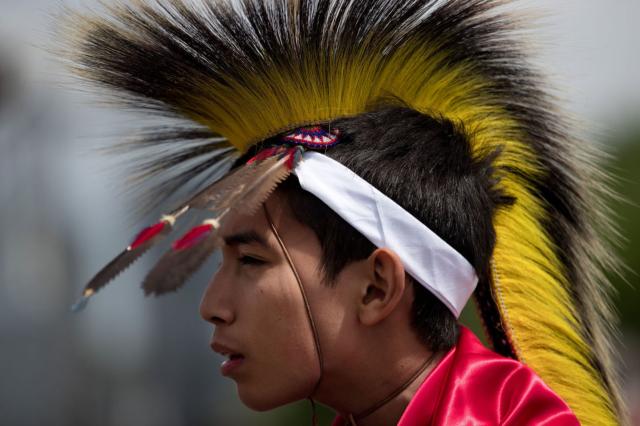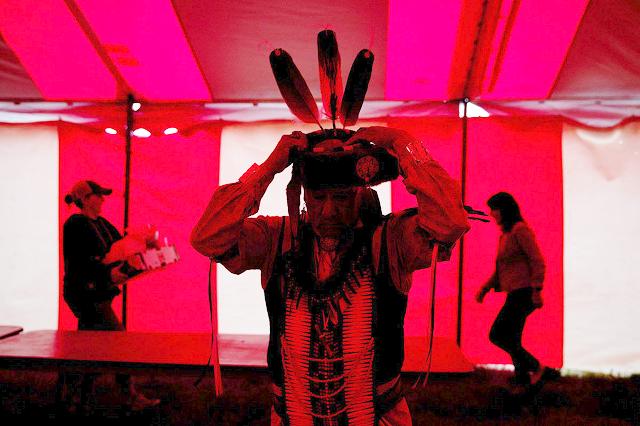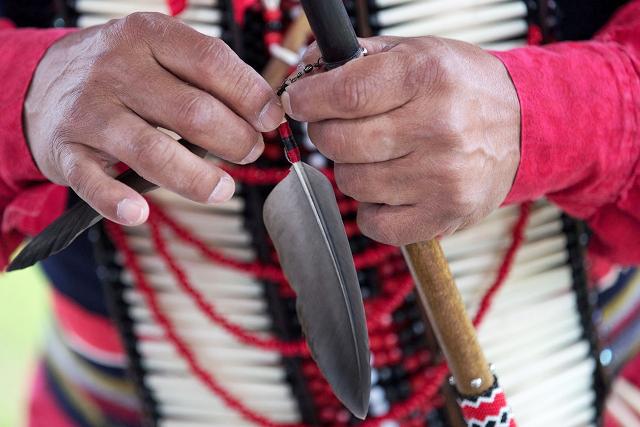 |
Canku Ota
|
 |
|
(Many Paths)
|
||
|
An Online Newsletter
Celebrating Native America
|
||
|
June 2017 - Volume 15
Number 6
|
||
|
|
||
|
With Native Song
And Dance, Ponca Tribe Celebrates As It Takes Ownership Of Chief
Standing Bear Trail
|
||
|
by Joe Duggan - World-Herald
Bureau
|
||
|
credits: (all photos
by Meagan Farmer - The World-Herald)
|
|
BARNESTON, NE — For so long, this sliver of land has pierced the hearts of the Ponca people. It is their trail of tears, a path trudged 140 years ago by more than 700 people at the end of bayonets belonging to a government the Poncas had never resisted. Soldiers forced men, women and children to relocate from their homeland along the Niobrara River to Indian Territory in Oklahoma, some 500 miles away. "That's where our people suffered and died," said Larry Wright Jr., chairman of the Ponca Tribe of Nebraska. "And every step that they took south was a step further from home — for many, a place they would never see again." Yet on Thursday, with a drum circle and traditional dancers, victory songs and prayers of thanksgiving, this sliver of land lifted the hearts of everyone who stood upon it. A symbol not just of sorrow, but of survival, the nearly 20-mile stretch of recreational trail now formally belongs to the Ponca people. The Nebraska Trails Foundation signed over the deed of the trail land to the tribe, which renamed the corridor the Chief Standing Bear Trail after the famed Ponca leader who won a landmark civil rights case for Indian people.
The deed-signing ceremony took place in Barneston, where the public recreational trail will feature a campground and a kiosk that encapsulates the story of Standing Bear and the Ponca Trail of Tears. "As long as we tell the stories of our ancestors, the Ponca will live forever," Wright said. Ross Greathouse, an officer with the trails foundation, said the group bought the former Union Pacific Railroad right of way in 2002. He helped raise $850,000 to deck 16 bridges and resurface the trail in limestone so it can be used by bicyclists, runners and hikers. "I don't know how many acres of land we've taken from the Ponca," he said. "Today, we're giving them 232 acres back."
The Ponca trail segment between Beatrice and Barneston is one leg of a roughly 75-mile trail that runs from Lincoln to Marysville, Kansas. The trail will be maintained by the Homestead Conservation Trails Association in consultation with the Poncas. The deed-signing also concluded a walk to commemorate the 140th anniversary of the Ponca's removal from Nebraska. More than 100 people, many of them Native American, left Niobrara in late April and walked 285 miles to Barneston. Spending the past two weeks "walking in the footsteps of our ancestors was very powerful, very emotional," said Randy Teboe, director of cultural affairs for the Nebraska Ponca Tribe. The 1877 journey by the Ponca was plagued by cold spring rains, blistering heat, thunderstorms and a tornado. Disease claimed the lives of several tribal members, including two young girls, who are buried in cemeteries in Neligh and Milford.
Standing Bear lost his daughter, Prairie Flower, along the way. In Oklahoma his son, Bear Shield, fell ill and, nearing death, asked his father to bury his bones in the land of his ancestors. Fulfilling his son's wish, Standing Bear and 28 members of the tribe were arrested in Nebraska. Standing Bear challenged his apprehension and return to Oklahoma, winning a federal court decision in Omaha that for the first time recognized Indians as persons under the law. Some Poncas returned to Nebraska. Others remained in Indian Territory. Several members of the Ponca Tribe of Oklahoma, including a drum group called Yellow Hammer and a group of female dancers called the Scalp Society, participated in Thursday's ceremony.
"It was not our choice. We were forced (to leave) yet we live," said Casey Camp-Horinek, a member of the Oklahoma tribe. In the area where the recreational trail now exists, the Poncas had to camp for two days in 1877 while they built a wooden bridge to cross a flooded creek. Members of the Otoe-Missouria Tribe, who lived on a reservation north of the Kansas border, brought food and ponies to the weary people, Teboe said. So the Poncas invited the Otoe-Missouria to Nebraska for the ceremony, and the tribe sent a strong contingent from its present-day reservation in Oklahoma. Rodney Sherman, a 24-year-old Ponca from Omaha who participated in the final three days of the walk, said he now feels a much stronger connection to that aspect of his heritage. The wind and sun burned his face and nearly 50 miles of running and walking left his legs heavy and sore. "I kept in mind that my ancestors were facing much harsher conditions than I was," he said.
Also attending the ceremony was Reyn Archer, chief of staff for U.S. Rep. Jeff Fortenberry, R-Neb., who co-sponsored legislation to study the designation of a national historic trail in honor of Standing Bear. Archer said the legislation has passed in the House but hasn't gained traction in the Senate, apparently over concerns that it would involve taking private land. No advocates for the designation, however, have argued that land should or needs to be condemned for a historic trail. Regardless, trail enthusiasts, history buffs and Native American leaders found a way to preserve a piece of the Nebraska trail, where it will forever exist as a place where anyone can walk in the footsteps of the Poncas. "The history of this trail is the history of America," said Sandra Washington, a board member with the trails foundation. "It is both grandiose and heartbreaking."
Bill
would replace Columbus Day with day honoring Chief Standing Bear,
other Native American leaders |
|||||||||||
|
|
|
|
||
|
|
||
| Canku Ota is a free Newsletter celebrating Native America, its traditions and accomplishments . We do not provide subscriber or visitor names to anyone. Some articles presented in Canku Ota may contain copyright material. We have received appropriate permissions for republishing any articles. Material appearing here is distributed without profit or monetary gain to those who have expressed an interest. This is in accordance with Title 17 U.S.C. Section 107. | ||
|
Canku Ota is a copyright ©
2000 - 2017 of Vicki Williams Barry and Paul Barry.
|
||
 |
 |
|
|
The "Canku
Ota - A Newsletter Celebrating Native America" web site and
its design is the
|
||
|
Copyright ©
1999 - 2017 of Paul C. Barry.
|
||
|
All Rights Reserved.
|
||
